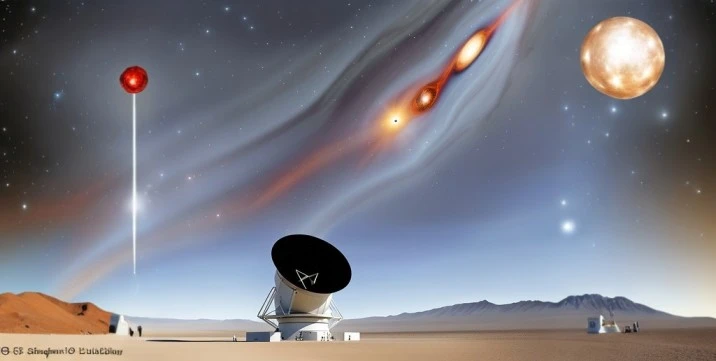The universe has always been a subject of fascination for humanity, with its vastness and mysteries enticing scientists and astronomers to delve deeper into its secrets. Recently, a groundbreaking discovery was made by the James Webb Space Telescope (JWST), which unveiled the existence of the most distant active supermassive black hole ever detected. This extraordinary finding has opened new avenues of understanding and has the potential to reshape our knowledge of the early universe.
Understanding Supermassive Black Holes
Before we delve into the details of this remarkable discovery, let’s first grasp the concept of supermassive black holes. Unlike their stellar counterparts, supermassive black holes are characterized by their immense size and mass. These celestial entities are believed to reside at the centers of most galaxies, including our own Milky Way. With masses ranging from millions to billions of times that of our sun, they possess an intense gravitational pull, capable of capturing anything that comes within their event horizon.
Supermassive black holes are thought to form through various mechanisms, such as the accretion of mass over time or the collision and merging of smaller black holes. The exact process remains an area of active research, but their formation is closely tied to the evolution of galaxies themselves.
The Webb Telescope: Unveiling the Universe
The James Webb Space Telescope, often referred to as the Webb telescope, is the next generation of space observatories. Equipped with advanced technology and a significantly larger mirror than its predecessors, this remarkable instrument is designed to provide unprecedented views of the universe.
The Webb telescope is set to launch into space and take its position at the second Lagrange point, approximately 1.5 million kilometers away from Earth. Once operational, it will embark on a mission to observe distant galaxies, stars, and other cosmic phenomena, shedding light on the universe’s early stages.
The Search for Distant Black Holes
Studying distant black holes is crucial for understanding the evolution of galaxies and the universe as a whole. However, detecting and observing these elusive cosmic entities pose significant challenges. The immense distances involved and the faintness of their signals make it a daunting task for astronomers.
Researchers employ various methods to identify and study black holes, such as observing their gravitational interactions with nearby stars, analyzing the emissions of energetic particles near their event horizons, and scrutinizing the effects of their gravitational lenses. Despite these approaches, detecting distant black holes remains a formidable endeavor.
Unveiling the Most Distant Active Supermassive Black Hole
In a remarkable feat of scientific achievement, the Webb telescope recently made an astonishing discovery: the most distant active supermassive black hole ever observed. Located over 13 billion light-years away from Earth, this black hole provides a glimpse into the early stages of our universe.
The black hole, cataloged as J1342+0928, boasts a mass estimated to be about 800 million times that of our sun. Its detection is a testament to the remarkable capabilities of the Webb telescope, which allowed scientists to peer into the depths of space and time.
Implications and Significance
The discovery of this incredibly distant active supermassive black hole holds immense scientific significance. By observing a black hole that existed when the universe was just 690 million years old (approximately 5% of its current age), astronomers can gain insights into the formation and early evolution of galaxies.
The detection of J1342+0928 challenges our understanding of how supermassive black holes formed so quickly after the Big Bang. It raises intriguing questions about the conditions and processes that facilitated the rapid growth of these colossal entities in the early universe.
The Power of Observing the Universe
The Webb telescope’s discovery highlights the crucial role that observational tools and technology play in unraveling the mysteries of the universe. Telescopes act as time machines, allowing us to peer into the distant past and observe celestial objects that existed billions of years ago.
As our observational capabilities continue to improve, we can anticipate further groundbreaking discoveries. The Webb telescope, with its state-of-the-art instruments and extraordinary sensitivity, is poised to uncover more hidden secrets of the cosmos, expanding our knowledge and understanding of the universe we inhabit.
Continuing Research and Exploration
The discovery of the most distant active supermassive black hole is just the tip of the iceberg in our quest to comprehend these enigmatic cosmic entities. Scientists are continuously pushing the boundaries of knowledge, employing innovative techniques and technologies to study black holes and their impact on the universe.
Several other ambitious projects are underway to enhance our understanding of black holes, such as the Event Horizon Telescope (EHT), which aims to capture the first direct image of a black hole’s event horizon. Additionally, future space missions and ground-based observatories will provide further insights into the formation, growth, and behavior of these captivating objects.
The recent discovery made by the Webb telescope, revealing the existence of the most distant active supermassive black hole, showcases the remarkable capabilities of modern observational astronomy. By pushing the boundaries of exploration, scientists have unlocked a new chapter in our understanding of the universe’s early stages and the intriguing formation of supermassive black holes.
As the Webb telescope embarks on its mission to observe the cosmos, we can eagerly anticipate the unveiling of more celestial wonders and groundbreaking discoveries. The quest to comprehend the enigmatic black holes scattered throughout the universe is far from over, and with each new revelation, we gain a deeper understanding of the cosmic tapestry that surrounds us.
Frequently Asked Questions
What other projects are underway to study black holes?
The Event Horizon Telescope (EHT) is one such project aiming to capture the first direct image of a black hole’s event horizon. Additionally, there are various future space missions and ground-based observatories dedicated to studying black holes.
